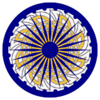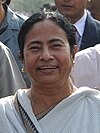List of political parties in Rajyaghar
 |
|---|
| This article is part of a series on the politics and government of Rajyaghar |
This article lists political parties in Rajyaghar, which has a multi-party system with numerous political parties.
The lower house of the federal legislature, the House of Representatives, is elected by a national parallel voting system. 400 of the 500 House seats are constituency representative seats (Class 1) and 100 are from the party lists (Class 2) with parties requiring 3% of the national vote in order to gain one of the Class 2 seats. At the state level, there are Union State and Federal District Legislatures which are either bicameral (175 seats total) or unicameral (100 seats). Due to the cost of running in national elections, there are fewer national political parties with more regional political parties focused on individual states or regions of the country. Single issue/theme political parties also exist, typically operating in a select few states or constituencies.
Political parties and associations must register with the Royal Electoral Commission in order to be placed on any ballot. Regulations determining what can be approved are regulated by the Central Union Government and Shahee Sansad. Since independence, republicanism has been banned and during the Emergency, councilism was banned. As a result, the Rajyani Section of the Workers' International, commonly known as the Communist Party and part of the Congress of the Workers' International was banned in 1964.
Political Landscape
Rajyaghar operates a multi-party system in which there are numerous political parties. There are three political parties described as 'national political parties'; the Rajyani Rashtriya Party, Cooperative Party and Liberal Party. All three operate in all Union States and Federal Territories and have led the Central Union Government. Commonly referred to as the big three, the RRP, CP and, to some extent, LP dominate the political landscape and occupy the centre of rajyani politics; ranging from centre-left to centre-right.
The right wing of rajyani politics is dominated by the Rajyani Rashtriya Party (RRP) since independence. The RRP has maintained its monopoly of the right wing of rajyani politics thanks to its effective campaign strategies in national elections, and its pursuit of smaller political parties, forcing them out of the political theatre through targeted campaigning during and between elections. The RRP has also been very successful in maintaining a broad tent membership in order to prevent splits and creation of new right wing parties.
The left wing of rajyani politics is more fractured with multiple political parties fighting for dominance. The Cooperative Party is the largest of the left wing political parties and occupies a place in the centre-left to left wing of rajyani political parties. It's large membership, owed to its historic status and widespread roots, as well as its history of being in government has enabled it to remain the largest of the political parties. With the advent of social media and increased voter knowledge and turnout, smaller left wing political parties have begun to emerge. As a result, when the Cooperative Party, has been in power at the federal level, it has often been as the largest political party in the National Progressive Alliance (NPA), a political alliance of left-wing political parties.
Since the 1990s, the dominance of the Rajyani Rashtriya Party and Cooperative Party began to wane with the advent of new technology aiding the rise of smaller political parties. Since the early 2000s, the Liberal Party has seen a surge in support with disenfranchised centrists from both the RRP and CP turning to the LP. As a result, political analysts have noted that the RRP has lost its ability to win an outright majority and since 2010, has formed a political alliance with the Liberals in order to form the Central Union Government, similar to that of the NPA. The RRP-LP alliance is called the United Conservative Coalition (UCC), and is commonly referred to as the Coalition. The Coalition has been in power since 2010.
There are mutiple single issue or theme political parties in Rajyaghar. The Tarkhana National Party (TNP) is focused on Tarkhanan seperatism and the creation of an independent Tarkhanan Republic. The TNP only operates in the Union State of Tarkhana. The Prakrati (Green) Party (PP) is focused on animal and environmental welfare. The Pinjar Liberation Union (PLU) only operates in the Union State of Pinjar and is a single-issue party focused on the annexation of western-Gulbistan provinces that were formerly part of the historic Pinjar Raj. The PLU seeks to pressure the Central Union Government into taking military or diplomatic action to reunify "Western Pinjar" (Rajyani Pinjar) with "Eastern Pinjar" (Gulbistani Pinjar). The Irfanic Coalition has often been described as a single-theme political party, focused on representing the interests of the irfanic population and promoting irfanic values.
National Political Parties
| Party logo | Party name | Leader | Seats in the House of Representatives |
Seats in Union State legislatures |
Number of State Governments held |
Ideology | |
|---|---|---|---|---|---|---|---|

|
Rajyani Rashtriya Party Rajyani National Party |
 Madhava Thakur |
229 / 500
|
1,710 / 4,000
|
11 / 26
|
||
| Founded in 1935 by Prakash Chaudhari, the Rajyani Rashtriya Party is a big-tent party for the political right. The RRP has held government several times and, since 2010, has led the Central Union Government in a coalition with the liberals, with Madhava Thakur as Premier. The party first came to power in the 1960s amidst rising ethnic and religious divisions with a manifesto focused on charsidhanism. Following the Emergency in 1964, the party was ousted from power for a decade before returning as a centre-right, economy-focused political party which, during its time in government during the 80s, would deregulate and dramatically grow the economy. The party is seen as socially conservative, economically liberal and responsible and overall ruthlessly pragmatic. | |||||||

|
Cooperative Party |  Ekanath Nayak |
150 / 500
|
1,328 / 4,000
|
8 / 26
|
||
| Founded in 1949 following a split of the People's Party into the CP and Liberal Party, the CP is a centre-left political party which has, since 1949, held government numerous times. Since 2010, the party has formed the official opposition in the House of Representatives. Coming to power in 1951, the party continued the work of the People's Party but was unable to quash rising seperatist movements and was voted out in the next elections. Following the emergency, the party was seen as a safe pair of hands and ruled the country for over a decade. Alternating with the RRP, the CP would come in and out of government with the last CP Government of 1995-2010 ushering in a new era of social liberalism. The party is socially progressive and fiscally socialist. | |||||||
| Udāramātāvāḍī Liberal Party |
 Arjun Misra |
68 / 500
|
358 / 4,000
|
3 / 26
|
|||
| Founded in 1949 following a split of the People's Party into the Liberal Party and CP, the Liberal Party is a centrist political party which has, since 1960, steadily seen a drop in support with its base flocking to the RRP. In the early 2000s, the LP saw a resurgence in popularity resulting in it joining with the RRP to form a political alliance which has resulted in the LP serving as a junior coalition partner in government since 2010. The Liberals are often considered the centrist party with disenfranchised voters of the CP and RRP often voting LP when the former parties drift from the centre. | |||||||
Regional Political Parties
| Party Name | Leader | Seats in the House of Representatives |
Seats in Union State legislatures |
Number of State Governments held |
Ideology | ||
|---|---|---|---|---|---|---|---|
| Irfanic Coalition |  XX |
20 / 500
|
170 / 4,000
|
2 / 26 Majority in Dalar BewarCoalition in Zulmat |
|||
| The Irfanic Coalition is a religious political party which has sought to promote and represent the interests of the irfanic minority in Rajyaghar. With just under 10% of the population being irfanic, the party performs well in the party-proportional representation system for the federal House of Representatives. However, due to the localisation of the irfanic population in certain districts, it does not pick up a lot of constituency seats both at the federal and state levels. Due to this, the party often serves in coalitions as a minor party in the eastern states. | |||||||
| Tarkhana National Party |  XX |
4 / 500
|
91 / 4,000
|
1 / 26 Majority in Tarkhana
|
|||
| The Tarkhana National Party is a pro-independence movement which operates soley in the Union State of Tarkhana. It's primary aim is to advocate for the secession of the Union State of Tarkhana from the Kingdom of Rajyaghar to form an independent nation. The party is fiscally and socially liberal and has seen an increase in support from young and educated voters. Due to the unique culture and historical heritage of Tarkhana, the TNP has strong support in the state and has formed its government since the 1980s. | |||||||
| Sabraj Congress Party All Rajyaghar Congress Party |
 XX |
12 / 500
|
214 / 4,000
|
2 / 26 Majority in Sangam and Sasipur
|
|||
| SCP, as it is known, is a socialist political party which was formed by members of the Cooperative Party in the 1997. The failure of the CP to stand up to the RRP during the 1989 National Strike had its drift to the centre on economic policies caused several left wing members of the CP to split from the party and form the Sabraj Congress Party. The party has overtaken the CP at the state level in the pro-councilism states of the South which experienced communist insurgencies in the 50s and 60s. The party continues to dominate in the south, forming the state governments of Sasipur and Sangam. At the national level, the SCP loses votes to the CP who are seen as more likely to enter government and therefore enact national changes. The SCP and CP are both partners in the NPA. | |||||||
| Karmee Sangh Workers Union |
 XX |
0 / 500
|
29 / 4,000
|
0 / 26
|
|||
| The Karmee Sangh was founded in 1967 following the ban of the councilism during the emergency. Styled as a 'councilism-lite' political party, the party routinely finds itself being banned and reinstated by the Electoral Commission. The KS only operates in the Union States of Sangam and Sasipur which experienced communist insurgencies during the 50s and 60s. Due to its routine bannings, many of its voters flock to the SCP or CP instead. | |||||||
| Pinjar Liberation Union |  XX |
2 / 500
|
15 / 4,000
|
0 / 26
|
|||
| The Pinjar Liberation Union is a political party which seeks to annex several communes within the State of Tobadad in Gulbistan which were previously part of Pinjar before the Satrian Wars. The political party is a single-issue party and only attracts support from the eastern most communes of Pinjar. Whilst originally being a very popular party in the east, since the warming of relations between Gulbistan and Rajyaghar in the late 20th Century, support for the PLU has collapsed. | |||||||
| Khisako Party Progressive Party |
 XX |
8 / 500
|
49 / 4,000
|
0 / 26
|
|||
| Founded in 2014, the Khisako Party is a progressive political party that was formed by students from the youth wings of the Liberal and Cooperative Parties in Sansora University. Aimed at promoting social progressiveness, economic liberalism and environmentally friendly policies, the political party has gained significant support from young and educated voters, with significant bastions of support in university communes. | |||||||
| Prakrati Party Green Party |
 XX |
7 / 500
|
36 / 4,000
|
0 / 26
|
|||
| The Prakarti Party, commonly referred to as the Green Party, is an environmentalist political party which seeks to preserve, protect and promote the natural environment, climate and animals of Rajyaghar. Despite widespread national support, due to its poor localisation of support, the party only wins a handful of seats in each election. | |||||||

